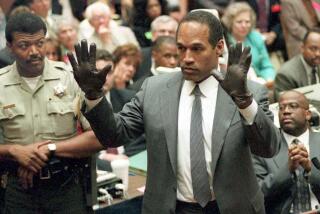More Stupid TV Tricks: News Dept.
- Share via
Stupid anchor tricks.
This one, a piece of news choreography that has become a staple of many local newscasts, is known as anchor involvement, a deceptive way of integrating people in the studio into stories being reported in the field.
And viewers of KNBC-TV Channel 4 got an especially comical look at it during Monday’s 5 p.m. newscast when anchor Paul Moyer asked the obligatory, scripted, arranged-in-advance, tell-me-what-we-both-already-know question following reporter Dan Rascon’s live stand-up in the field concerning the Los Angeles Unified School District’s plans to use metal detectors to screen students for weapons at high school entrances.
With great earnestness, Moyer asked Rascon if the detectors would be used on a “spot-check basis.”
But technical problems were stopping Rascon from hearing Moyer.
Moyer tried again, repeating the question.
Again, Rascon couldn’t hear.
Finally, Moyer gave up. “I’m sorry, I had you at a disadvantage,” he told Rascon, who presumably still couldn’t hear. “It will be on a spot-check basis.”
But if Moyer already knew the answer to the question he was asking, why had he asked it? And if Rascon knew the answer to the question he was going to be asked--involving a critical piece of information--why had he omitted it in the first place?
Because they’re on television, dummy.
More Tricks: The CBS News series “60 Minutes” is truly a phenomenon. Year after year, it affirms its standing as one of television’s most arresting hours, an irresistible hybrid of entertainment, superb storytelling and personality driven journalism that has become not only the most popular news series ever (topping the prime-time ratings again this season), but one of the most influential as well.
And unfortunately, as its critics have charged through the years, also one of the shiftiest when it comes to tailoring a story to a particular point of view.
The latest case in point: Sunday’s segment on Dr. Michael E. Carey, professor of neurosurgery at Louisiana State University Medical School, and the controversy over his Army-funded research in which approximately 700 anesthetized cats were shot in the head to study treatment of head wounds.
Although that $2-million research project was discontinued in 1989, in conjunction with a probe by the General Accounting Office (GAO), Congress’ investigative arm, “60 Minutes” appeared Sunday to be lobbying aggressively for its resumption.
The anti-Carey crowd took a devastating hit during the program when a woman retracted on camera her previous charge that she had heard the cats in Carey’s lab loudly crying in pain.
Then, too, the show’s 13-minute story--reported by Mike Wallace, produced by Ariadne Allen and overwhelmingly favorable to Carey and the concept of using animals in biomedical research--gave just over a minute to Dr. Neal Barnard, head of the anti-vivisection Physicians Committee for Responsible Medicine.
Barnard was the only anti-vivisection physician or animal rights spokesperson interviewed in the segment, and the time allotted him was a mere blip against that given Carey plus an American Medical Assn. spokesman and two members of a GAO-named physicians panel that Wallace said concluded that Carey’s research was “unique, worthwhile and should be continued.”
Wallace said that a congressman who pushed for the GAO investigation of Carey’s research--and who the AMA spokesman charged had been “hoodwinked” by animal rights “zealots”--refused to speak on camera. However, there also were no interviews in the segment with GAO officials or with members of a GAO-formed panel of animal anesthesiologists that did not endorse Carey’s cat-shooting studies, charging that his anesthesiology techniques “skewed” his research.
Speaking of skewing, it was not only what “60 Minutes” didn’t do, but also what it did do--with images--that distinctly favored one side over the other. In contrast to the responsible Establishment figures of Carey (repeatedly shown also in the military fatigues he wore as a surgeon in the Vietnam and Persian Gulf wars) and his physician supporters, the animal rights figures on screen consisted of people marching, waving banners and shouting shrilly in the streets. Barnard was the lone exception.
As if to underscore that zealot stereotype, Wallace twice misquoted a tenet of many in the animal rights movement, saying they and Barnard believed “a rat is a cat is a dog is a pig is a boy.” The actual quote, from Ingrid Newkirk, who heads People for the Ethical Treatment of Animals, is: “When it comes to feelings like pain, hunger and thirst, a rat is a pig is a dog is a boy.” The difference is more than subtle.
While serving in the Persian Gulf, Wallace said, Carey saved the lives of soldiers “using some of the techniques he was developing in his lab.” Next came footage of a young man, followed by some nifty juxtaposition of his mother-in-law saying that if not for Carey, “my son-in-law would be dead.”
So there it was--without scientific validation or even a raised eyebrow from the oft-skeptical Wallace--”evidence” on the screen that shooting cats in a lab had saved this former GI’s life.
Because, in effect, “60 Minutes” said it had.
More to Read
The complete guide to home viewing
Get Screen Gab for everything about the TV shows and streaming movies everyone’s talking about.
You may occasionally receive promotional content from the Los Angeles Times.






